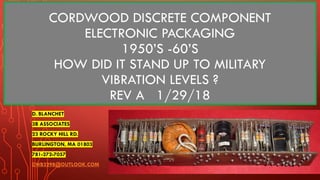Cordwood electronic packaging
- 1. CORDWOOD DISCRETE COMPONENT ELECTRONIC PACKAGING 1950’S -60’S HOW DID IT STAND UP TO MILITARY VIBRATION LEVELS ? REV A 1/29/18 D. BLANCHET 3B ASSOCIATES 23 ROCKY HILL RD. BURLINGTON, MA 01803 781-272-7057 DWB3298@OUTLOOK.COM
- 2. IN THE YEARS PRIOR TO THE WIDESPREAD USE OF THE INTEGRATED CIRCUIT AND MULTILAYER PWB’S • Printed wiring boards were crude low density with single or 2 sided traces. • Trough holes connected with soldered wires or pressed in eyelets. • Electronic circuit elements were in single discrete form usually with axial connection leads. • Point to point wiring was often used implemented with manual soldering. • Heat density was low and natural convection cooling was usually sufficient. • High power parts such as those located in power supplies often had individual heatsinks attached. • High Packaging density was often achieved through the use of a technique known as CORDWOOD MODULES.
- 3. Early Sparrow Missile Guidance Electronics Hinged cylindrical aluminum platters, Pressed in insulating standoffs Some thin pwbs single trace layers Point-to-point wiring interconnect. VERY SHORT SERVICE LIFE TACTICAL WEAPON SYSTEM
- 4. AVIONICS
- 5. FEA SOLID MODEL TYPICAL CORDWOOD BENCH DESIGN Breadboards & Brassboards Used for bench Testing and debugging Were often used In tactical Prototype aircraft
- 7. RANDOM VIBRATION PROFILES –TACTICAL JET F15
- 8. FATIGUE LIFE NON FERROUS COMPONENT LEADS 10,000 psi
- 9. BASELINE FIRST MODAL FREQUENCY 123 HZ
- 10. RESULTS: MAXIMUM DISPLACEMENT .042 INCHES
- 11. RESULTS: MAXIMUM STRESS , 6250 PSI
- 12. IN SERVICE LIFE ESTIMATE JET FIGHTER MAX VIBRATION ENVELOPE • @ 6250 psi 3 sigma lead bending stress ---- approx. 1e06 cycles to failure • @ 123 hz resonance (1e06) / (123) = 8130 seconds • 8130 sec / 3600 sec/hr = 2.25 hours
- 13. SIMPLE MODIFICATIONS TO INCREASE SERVICE LIFE Add 2 Additional Mounting feet Add 4 Hexagonal spacers
- 14. FIRST MODAL FREQUENCY RUGGEDIZED = 294 HZ
- 15. CONCLUSIONS CASE RESONANT FREQUENCY MAX 3-SIGMA STRESS, PSI IN SERVICE LIFE EXPECTATION HOURS BASELINE DESIGN 123 6250 2.25 RUGGEDIZED 294 4460 175.00















